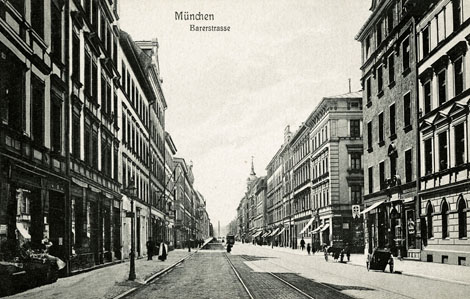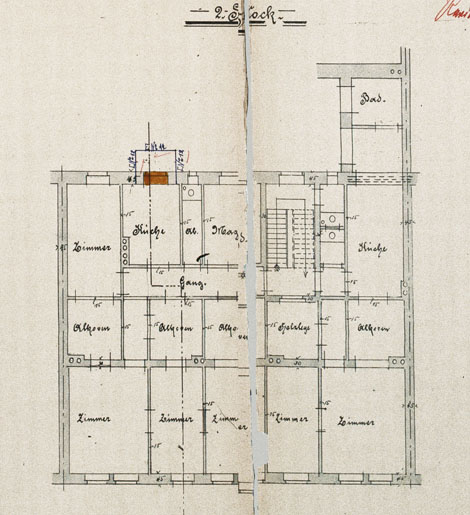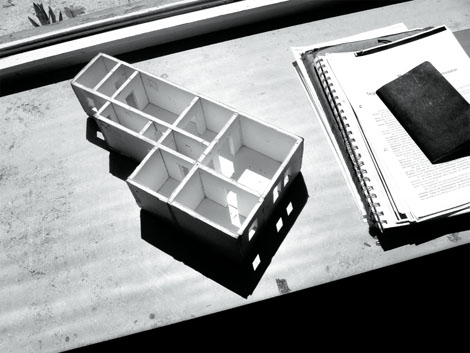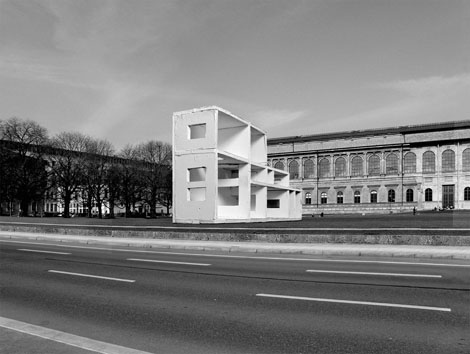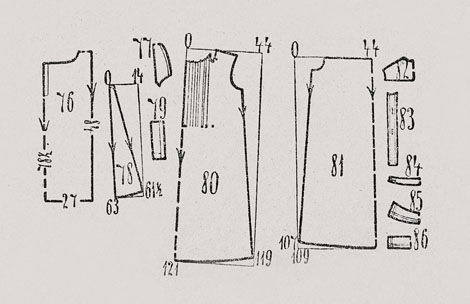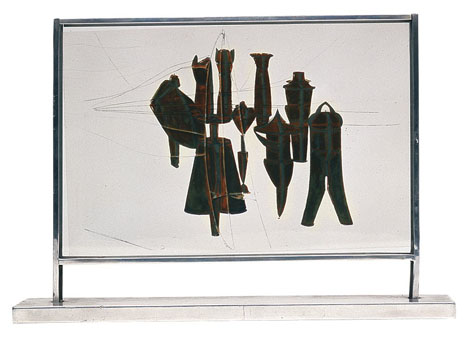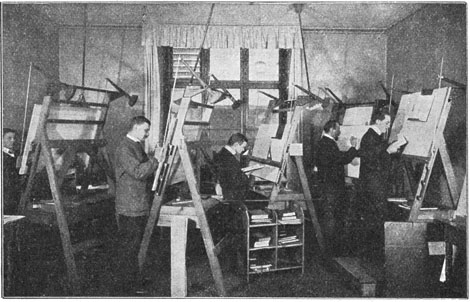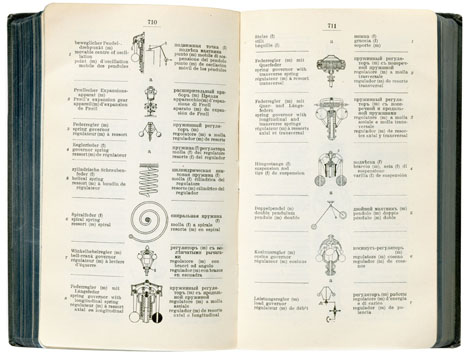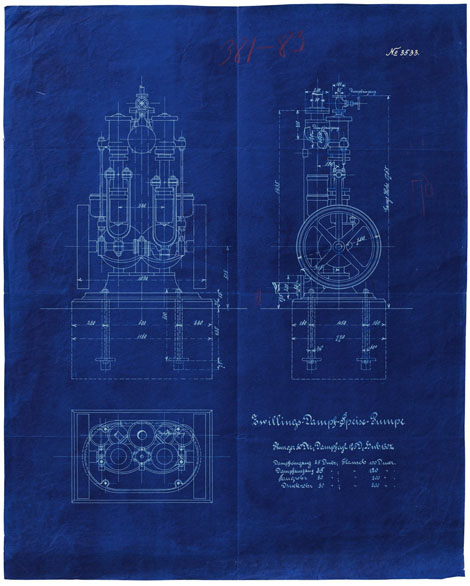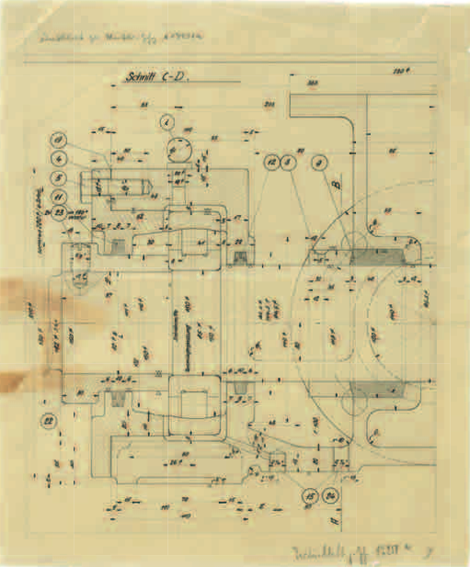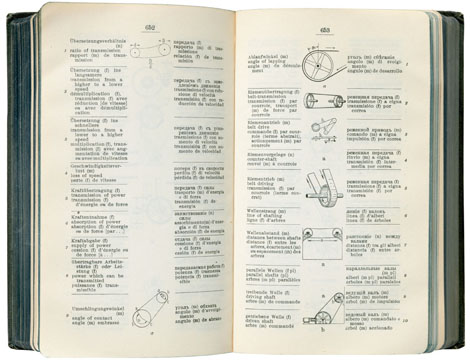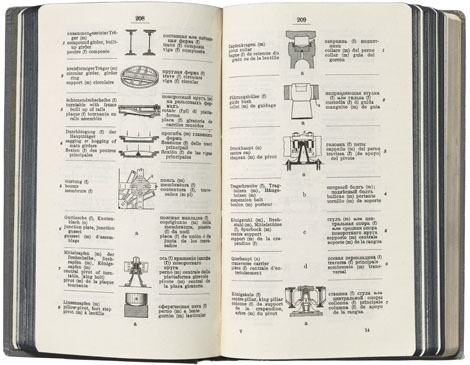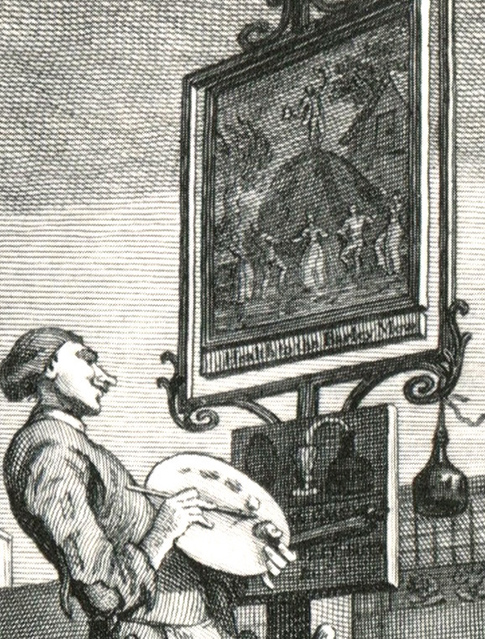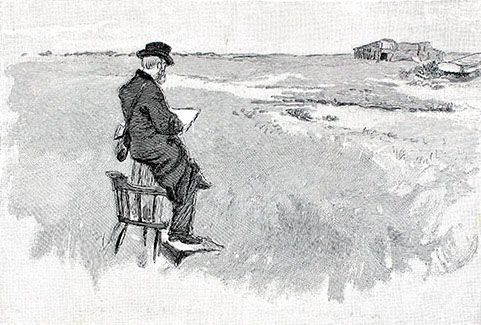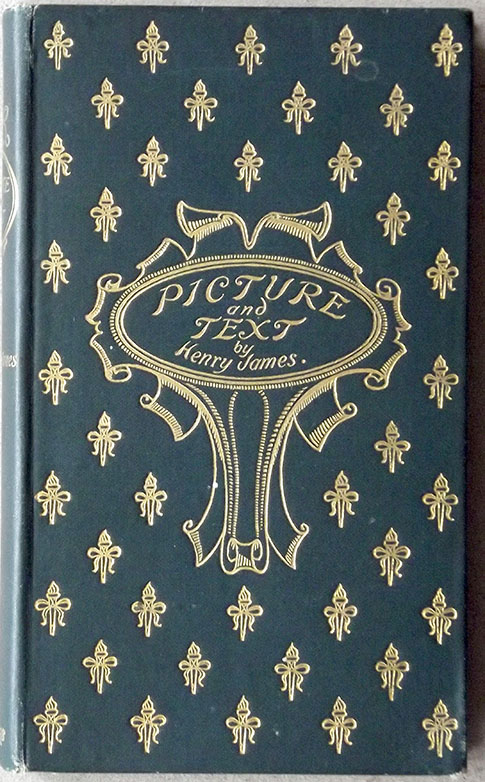Rudolf Herz]
[June 21, 2012
“The technical drawing was the answer” – August Greß, the engineer behind Marcel Duchamp´s Large Glass
The three months which 25-year-old Marcel Duchamp spent in Munich from the end of June to the end of September 1912 are judged by researchers as both the most enigmatic and momentous episode in the artist’s career. In a lecture from 1964, Duchamp himself called his stay in the Bavarian capital, which was a culturally vibrant centre at the time, the place of his “total liberation”. Yet what he exactly meant had to remain unclear, for the master of mystification and indifference sought to carefully delete the traces of his visit to Munich. In interviews, he merely suggested that he had spent a time of strict artistic seclusion there. He lived in a hotel and hardly had contact with living persons, but regular dealings with the dead masters of the Alte Pinakothek. But once the police registration form was found, at the latest, these statements could be exposed as an act of self-mystification, for the hermit had by no means spent his time as a hotel guest but had instead taken lodgings with the engineer August Greß and his wife Theresa at Barerstraße 65. Earlier researchers were satisfied with this fact, because such a mundane tenancy appeared hardly worth mentioning in the context of art-historical research. Moreover, the tenement house was no longer available as evidence, it was destroyed in the war.
Barer Straße around 1910, hidden in the picture, front right: Barer Straße, houses no. 63 and 65
Building plan 1898, Barer Straße 66, 2nd floor (records of the local planning commission Munich, Stadtarchiv Munich)
This was the not very promising point of departure of artist and media researcher Rudolf Herz’s work. Herz had come upon the mystery of Duchamp’s time in Munich during the course of his investigations on Hitler’s personal photographer, Heinrich Hoffmann, because Duchamp’s visit to Hoffmann’s photo studio is one of the few evidences of his stay. He had a publication by Guillaume Apollinaire on Cubist painters photographed there, even though he was on the verge of distancing himself from this art movement. He had arrived in Munich as a frustrated painter, whose “Nude Descending a Staircase” was barred from the Parisian Salon des Indépendants by the Cubist orthodoxy, and after a few months he left the city again as a budding Conceptual artist, in his baggage the first sketches for the large glass work and a “dry” conception of sculpture that a short while later would be reflected in the realisation of the first readymade.
The mystery of what triggered this paradigm shift in Munich has preoccupied researchers for quite some time. Shortly before his departure, Duchamp became interested in the theory of the fourth dimension. As opposed to his Cubist colleagues, he wanted to delve into the propositions of non-Euclidian geometry in a more analytical way and establish a new art based on them. There are speculations about revelations he had in connection with the technical collection on view at the Deutsche Museum, yet there were comparable collections dedicated to industrial culture in Paris as well. The investigations of Rudolf Herz have added a surprisingly dense web of hard facts to such assumptions, from which a much more vivid picture of Duchamp’s time in Munich can now be extracted. He came upon further documents, including the ground plan of a flat, a newspaper advertisement and CVs. Herz himself concretised the spatial dimension of his diverse and protracted research in an impressive outdoor sculpture. The “built thesis” is on view starting 21 June, the day Duchamp arrived in Munich, for three month in front of the Alte Pinakothek on Barerstraße. It presents the flat of the Greß couple, which Rudolf Herz presumes to be “the cradle of Conceptual art”, as a model on the scale of 1:1, tilted by 90 degrees.
Rudolf Herz: Le mystère de Munich. Prototype, Scale 1:50, photo: Hans Döring
Rudolf Herz: Le mystère de Munich. Sculpture in front of the Alte Pinakothek, montage: Hans Döring
The sculpture conveys insights into the “scene of a crime”, giving criminological serendipity great leeway. The layout of the rooms makes it clear that it was difficult for the French subtenant to separate himself in these quarters. He couldn’t enter his studio-room without encountering the artefacts of Ms Frau Greß, who made her own living as a dressmaker. Here, a world of sewing patterns, dress forms and technical drawings opened up to him, which would from then on dominate his work. It is the merit of Rudolf Herz’s reconstruction that it doesn’t marginalise Duchamp’s acquaintances any further, but instead lends them, as far as possible, an autonomous biographical contour. Hence, in the fog of the Munich mystery, the figure of an urbane and widely travelled engineer emerges, who was not just a technician but a specialist in technical illustration graphics with a broad intellectual horizon.
Deutsche Wäsche- und Handarbeitszeitung, sewing pattern no.39, issue 3, year 1912
Marcel Duchamp: Nine Malic Moulds (Neuf moules mâlic), 1914-15/1938 (reproduction 1964)
August Greß
What is interesting about August Greß’ career is that is provides us with an example of the way in which modern technology developed: mass mobility and the large scale transport of goods, global electrification, the internationalisation of communication and trade relations, the trend towards a scientific approach and professionalism in trade and commerce, and later on the production of cannons by Krupp.
Greß began his career as a trainee at F.A. Maffei, one of the largest industrial enterprises in Munich, where he was employed in various workshops. At the end of 1909 he took up a position as engineer at C.A.T.E. (Companía Alemana Transatlántica de Electricídad) in Buenos Aires. According to his curriculum vitae, he was “employed as head of the electro-mechanical workshop during the construction of the new power station Doc Sud”, with promotion to operating manager once the power station was operating. It is surprising that the 22 year old was entrusted with such a position, particularly as he had not previously held a post of this nature. The company must have thought highly of the young engineer from Munich. After just over a year, he left Buenos Aires to return to Munich where he worked in the editorial department of the “Illustrierte Technische Wörterbücher” (Illustrated Technical Dictionaries), issued by the Oldenbourg publishing house, and was soon in charge of the drafting office – until its closure at the end of 1911. At Oldenbourg he had already worked temporarily as “draftsman for small scale drawings” in 1909. After a short intermezzo at C. Mohn, Mühlenbau und Maschinenfabrik [a company specialising in the construction of mills and machinery] in Munich, he returned to F.A. Maffei in April 1912. In mid-1914 he started negotiations for a position as secretary of the “Polytechnischer Verein” (Polytechnical Society), but the war prevented him from taking up this post until 1919.
Drawing room in the offices of the “Illustrierte Technische Wörterbücher” (R. Oldenbourg Publishers, Munich), photograph in an advertising brochure, 1909
It was a remarkable career. Greß held diverse positions in well-known companies. The professional field of the engineer had diversified greatly as a result of the manifold technical tasks such as research, development, construction and production control. The “goal and the ideal of engineering education” is the constructor and machine building is the most important field. Indeed, being a capable draftsman was an engineer’s key competence when it came to planning and designing. The engineers who had just finished their training were all required to start “at the bottom” as draftsmen. Even Emil Rathenau, who later founded AEG, was forced to begin his career as a draftsman at the Berliner Lokomotivenfabrik Borsig (Berlin Locomotive Factory) even though he could prove that he had trained as an engineer.To this extent, the beginning of Greß’ career was typical. And yet, until now we know of no design, no engineering product, no machine which was created by Greß. It was not usual for the designer’s name to be marked on an engineering drawing. Nor were the names of the draftsmen given in the imprint of the dictionaries.
1. F.A. Maffei
At F.A. Maffei Greß worked in the “Beer Office”. It is not clear which division the “Beer Office” belonged to and what Greß actually did there. Konrad Beer (1870-1921) was not one of the famous designers of Maffei Locomotives such as Anton Hammel or Heinrich Leppla. No further information can be found in the remaining documents. Beer’s grandchildren had different opinions about what their grandfather did. For some, he was involved in the construction of steam locomotives and in the development of electric locomotives, others view him as an engineer in the field of large stationary steam turbines and steam power plants.
The Steam Engine Factory F.A. Maffei was founded in 1838 and was, for a long time, the place to go to for steam engines in Southern Germany.It went into liquidation in 1931 and was taken over by its Munich competitor Krauss. Until then the company had built over 5000 steam and electric locomotives. The factory was situated in Hirschau, in the northern part of the English Garden. 1912 was a boom year, in this pre-war period up to 2000 people were employed. Because orders for locomotives were placed irregularly, the company also built stationary steam power plants, steamships and steam presses and founded a subsidiary company, which manufactured steam turbines.
J. A. Maffei: undated construction drawing, blueprint
The trains of the railway companies were becoming increasingly heavy, so that they were asking for more powerful express locomotives. The culmination, the conclusion, and for many contemporaries also the aesthetic peak of locomotive construction was the type S 3/6, of which 150 examples were built. In 1907 its predecessor S 2/6 set the world speed record for steam engines at 154 km/hr. Maffei engines were in use all over the world, and during the war the company played a central role in the German war economy. In cooperation with the Army Ordnance Office, Maffei and later Krauss-Maffei constructed half-track vehicles and, later on, tanks. In the course of the German re-armament after the Second World War the battle tanks Leopard 1 (1965) and its successor Leopard 2 (1979) were developed and became bestsellers of the international arms business. The locomotive division (including the magnetic levitation train and the ICE) became part of the Siemens AG in 2001.
2. Illustrierte Technische Wörterbücher (Illustrated Technical Dictionaries)
As a draftsman, Greß was involved in one of the most ambitious and most expensive publishing projects, the “Illustrierte Technische Wörterbücher” or ITW (Illustrated Technical Directories). In this case we possess precise information about the environment and his function. The idea for the dictionaries came from engineer Alfred Schlomann. He wanted to take the “scientific importance of German technology” and the “economic development of German industry, which extends far beyond the borders of Germany” into account and overcome the barriers of language. The ITW was meant to distinguish itself from existing dictionaries by virtue of its internationality, the involvement of specialist engineers and its arrangement by specialist areas of expertise. Its focus was to be technical illustrations. Schlomann was convinced that: “The technical illustration is … the soul of all international communication”. And wrote: “Every technical term refers to an object which one can represent precisely and unequivocally by means of a simple sketch or a chemical or mathematical formula. What, for example, an articulated flange or a gland seal or a massive crosshead is, or what we mean by a transmission belt riding too high, can only be explained long-windedly and incompletely in words. A sketch, on the other hand, explains this with a few strokes of a pencil. And a sketch has the advantage that everyone understands it in their own language. With a few strokes we can, for example, draw a screw. People who could not otherwise communicate with one another will immediately think of the name of the illustrated object in their mother tongue.”
Illustrierte Technische Wörterbücher, Vol 3, München 1908
Schlomann had persuaded the Munich publishers R. Oldenbourg to publish the reference works. It was decided that they would be released in six languages (German, English, French, Russian, Italian and Spanish) and a central editorial office was set up with a staff of 20 and an international staff of around a thousand freelance specialists as contributors, and regular international conferences were held in cooperation with technical universities and the industry. The first volume “Mechanical Components and Standard Tools” was published in 1906.
Soon after his return from Argentina he took over the management of the drawing office, which was under the control of an engineer, in order to coordinate the workload. This comprised a significant number of accurate drawings. Each volume contained between 2200 and 15000 textual entries. In the finance plan for 1912 the workload is described as follows: “On average there will be one drawing to every three text entries. Since the editorial office is expected to generate 10000 text entries per year, some 3300 drawings will have to be produced in that time. The average monthly output of a draftsman is 100 drawings. Taking holiday entitlement, public holidays and sickness into account, only 11 working months can be assumed. So 3 draftsmen will be needed, each of whom will complete 1100 drawings, and these 3 draftsmen will provide the 3300 drawings which are required for 10000 word entries.”
By 1911 eleven dictionaries had been published, then the undertaking faltered. The original assumption was that it would cost 1.50 Marks to edit an entry, but the actual cost of an entry turned out to be 10 Marks. The whole project was running into trouble, the costs had exploded at all levels and, at the same time, the sales of the dictionaries had not been as good as expected. Only after the “Kreise der Technik” agreed to subsidise the project were the publishers prepared to continue the series. Volume 12 appeared in March 1915. Mastering the immense, permanently expanding world of technology was a bold undertaking. 30 volumes had been planned. Even though the pressure to remain up-to-date might not yet have been so great, the project was in a race against time since technical innovations had to be taken into account and the various volumes were soon outdated. In addition, the publishers laid great emphasis on dependability, international validity and consultation. Of each galley-proof, for example, 500 copies were distributed.
3. C.A.T.E. / Dock Sud
At the turn of the year 1909/1910, August Greß moved to Buenos Aires for C.A.T.E in order to help with the expansion of the power supply and was involved in the extension of the “Central Station for Alternating Current”. C.A.T.E was the largest electricity company in Argentina and held a monopoly for the electricity supply in Buenos Aires. Founded in 1898 by AEG and a banking syndicate under the leadership of the Deutsche Bank, it evolved into the largest German overseas company before the First World War. The aim was to supply South America with electric power and to electrify the tramway systems, which still used horse-drawn trams. This was a financial success and the company expanded into several South American states and achieved an annual return of up to 11%.
In 1907 the company won the concession to use “public roads, spaces and bridges for the generation, distribution and sale of electric energy in the municipal area”. In order to meet the greatly expanding demand for power in Buenos Aires, the generating capacity was constantly increased, and soon comprised six thermal power plants. In 1907 the construction of the largest coal-fired power station, Dock Sud, began in Avellaneda, an industrial suburb of Buenos Aires. In order to provide a foundation for the power station, thousands of piles were rammed into the seabed. The annual report for 1910 says “The first phase of Central Station Dock Sud with a capacity of 30000kW went into service in May of the current year. Because the growth in users and the sales of energy have appreciably exceeded our expectations, and taking into account the expected development in the coming years, we have already decided to expand the output of the central station by 27500 kW with a corresponding growth in substations and the electric grid.”
4. Polytechnischer Verein in Bayern (The Bavarian Polytechnic Society)
Greß had long been in close contact with the Polytechnic Society before he received the offer to become its secretary.The society had a long history and was founded as early as 1815 with the aim of “furthering the diligence of national arts and crafts”. Its members consisted of the owners of the leading factories in Munich, officials, professors and engineers.Its goal was to represent the interests of industry and trade and to further the setting up of industrial areas in the city, for which good contacts with municipal and governmental institutions were necessary. Until the patent office was established it was responsible for producing technical assessments and issuing patents. The society was involved in all industrial and trade exhibitions, published the “Bavarian Industry and Trade Journal” and held regular lectures and events. The society was disbanded in 1938 and incorporated into the “Office of Technical Studies of the German Labour Front”.
The engineer behind the Large Glass
Technology historian Eugene Ferguson contends that the art of the engineer is fundamentally non-verbal thought and develops in front of the inner eye. According to him the engineers calls up individual elements in his memory, alters them, joins them together differently and, in this manner, creates appliances on paper which do not yet exist: “Design and invention lie on a continuum between the obvious and the ingenious, between a routine which requires a minimum of intellectual effort and novel, fundamental inventions which will forever change the way we approach a problem.” How inventive was Greß? At the locomotive factory he might have worked on technical modifications to standard models according to the clients’ requirements, or on developing new turbines. Ferguson remarks on the similarity between technical and artistic drawings: “Both start with an empty page. Each one wants to fill it with the vision of his inner eye.” And he continues: “The decisions taken by the artist when creating his picture seem to be entirely arbitrary but are governed by the aim of ultimately communicating their visions, insights and creation of meaning to others. … When an engineer wants to make a drawing of a structure – a machine, a building or a system – this will seemingly leave him with very limited choice. In reality, though, the technical design is surprisingly free. One can reach a goal in many ways, some of them are better than others, none of them, however, is the best.”
J. A. Maffei: undated construction drawing, blueprint
J. A. Maffei: undatierte Konstruktionszeichnung, Transparentpapier
Greß and Duchamp were creators of pictures but their self-images could not have been more different. Duchamp had already shown an interest in technology before coming to Munich, liberating the technical visual vocabulary from all painterly attitudes and reducing it to its essence, this is something he only achieved thanks to his Munich experiences. They were recorded in an archive of ideas which he could draw upon for his sketches and preliminary studies to the “Large Glass”. In the different preliminary studies for the “Large Glass” Duchamp repeatedly made use of the medium of technical drawing. When questioned about the technique of the “Chocolate Grinder” from 1913 he explained: “I could not let myself use random drawing or painting, the splattering of paint; I wanted to go back to a completely matter-of-fact drawing, a down-to-earth concept of art. And for me the technical drawing was the best form for this down-to-earth concept of art.”
He could find plenty of this in Greß’ flat. One can assume that there were examples of the “Illustrated Technical Diaries” from Oldenbourg Publishers, maybe also galley proofs of the last volumes. In April 1911 the 784 page strong volume on “Ironworks” had been published, Greß was responsible for the illustrations of the following volume, no.12 (“Water technology, Air technology, Refrigeration”), as manager of the drawing office. Here we find a wealth of small-scale illustrations, diagrams and cross sections of compressors, cranes, tilting machines, water wheels, pumps, wind power generators, belt drives, hydraulic constructions and gauges, often with arrows added, and annotated in six languages, among them French. Images of a world of technology typical of the time, devoid of people, in almost overwhelming detail. These drawings feature permanent rotation, pulling, pounding and pushing. What Duchamp could see here in hundreds of variations was the visual vocabulary of the technical drawing, the depersonalised engineer’s drawing, which is of no expressive value and is not meant to reveal any kind of personality. For Duchamp, who had already discovered the artistic game with language, the written section provided an enormous pool of inspiration. His notes in the “Green Box” contain several technical terms which we can also find in the dictionaries: Steam engine, internal combustion engine, vane, radiator … For the sphere of the bachelors a “steam engine with a brick foundation” was planned.
Illustrierte Technische Wörterbücher, Vol 5, München 1909
Illustrierte Technische Wörterbücher, Vol 3, München 1908
In any case Duchamp had few other contacts there and spent a lot of time in close proximity to an engineer and a seamstress. Their influence is obvious even though it cannot be proved in detail. The fact that motifs from the world of technology and tailoring appeared on his horizon simultaneously makes the special role of this inspiring flat so plausible.i Pierre Cabanne said to Duchamp: “”From an anti-artist you now turned pro-engineer.” To which the latter replied: “ Yes…, but a minor-engineer. One of her stronger proofs is the episode already mentioned in which Fernand Léger speaks of a joint visit to the Paris Aviation Exhibition, the “4e Exposition de la Locomotion Aérienne” in the late autumn of 1912: “Before World War I went to an exhibition of aircraft with Marcel Duchamp and Brancusi. Marcel, who was a dry kind of person and who had a sort of intangible air about him, walked between the engines and propellers without saying a word. Suddenly he turns to Brancusi: ‘Painting is dead. Who can create something better than these propellers? Can you?’”
There are many arguments in favour of August Greß being the missing link, that, in fact, the close contact between artist and engineer in the summer of 1912 had far reaching consequences. Adopting the engineer’s way of drawing was to have a far greater impact than all past transfers from non-art-related areas with the help of which Duchamp had attempted to modernise painting: Chronophotography, x-rays and anatomical and gynaecological depictions. Formally cubism had turned out to be a dead end. In 1965 he said to Tomkins: “The technical drawing was the answer – a straight line, drawn with a ruler instead of by hand, a line which was guided by the impersonality of the ruler. The young man rose up against the old-fashioned tools and tried to contribute something which the forefathers had never thought of. Maybe [this was] very naïve of me! I never freed myself entirely from the prison of tradition but I tried to – deliberately. I unlearned how to draw. The crucial point was forgetting my hand.”
(Rudolf Herz: „Marcel Duchamp – Le mystére de Munich“ will be available in an English version , published by Horst Moser, München)
